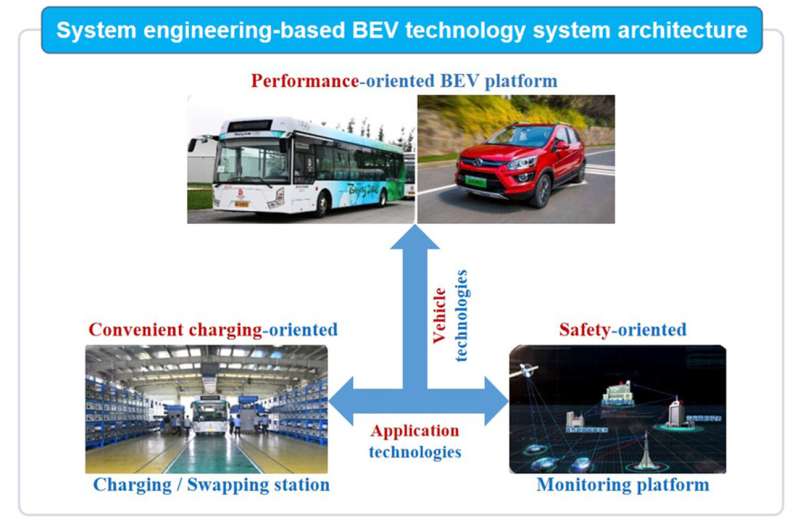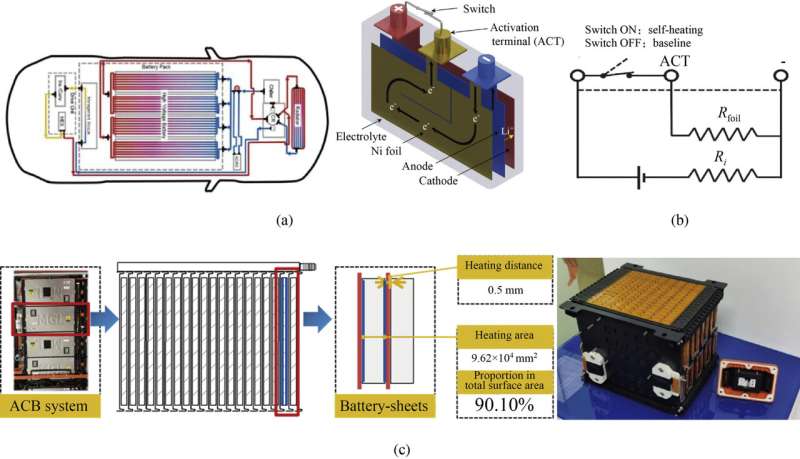This article has been reviewed according to Science X's editorial process and policies. Editors have highlighted the following attributes while ensuring the content's credibility:
fact-checked
proofread
Examining how China's battery electric vehicles lead the world

A paper describing the achievements and technological breakthroughs of China's battery electric vehicles was published in the journal Green Energy and Intelligent Transportation. Researchers summarizes the current research situation and progress of the three core components of "technology system architecture for BEVs," namely, BEV platform, charging/swapping station, and real-time operation monitoring platform, and their key technological points.
Due to the late start and weak foundation of China's automotive industry, especially its dilemma of long-term dependence on imported key technologies such as automatic transmission and electronic engine control, developing EVs has become an important choice for China's automotive industry to achieve "lane changing and overtaking."
This process can be divided into the following four stages. The first stage started in the early 1990s. The second stage started at the beginning of this century, a time that coincided with China's tenth "Five-Year Plan" period. The third stage was the demonstration application stage marked by the green transportation of the 2008 Beijing Olympic Games. The fourth stage began in 2014, the first year to open the era of Chinese electric vehicles' commercial application.
To systematically solve the key problems of battery electric vehicles (BEVs) such as "driving range anxiety, long battery charging time, and driving safety hazards," China took the lead in putting forward a "system engineering-based technology system architecture for BEVs" and clarifying its connotation.
The three key technologies of BEVs consist of motor and controller, battery and management system, and vehicle controller. And the current technical research is focused on promoting the power density, system efficiency, and control performance of the motor drive system, enhancing the energy density, safety, and durability of the power battery system, and improving the vehicle-level control system architecture to achieve intelligent integrated control, reduction in energy consumption, improvement of the all-climate adaptability and all-day safety of EVs.

The construction of charging/swapping compatible infrastructure, the application of new technologies such as wireless charging, and the integrated control of vehicle-pile-grid interconnection are the keys to systematically solving the charging problem of BEVs and improving the convenience of use. As the driving range of BEVs increases continuously, the demand for new charging technologies such as super-fast charging and charging with micro-grid energy storage is evident.
Solving the operational safety problems of BEVs is crucial. To this end, improving operational safety monitoring based on the terminal-network-cloud architecture, building a digital twin model of power batteries, enriching diagnosis methods for BEV power battery SOH, improving safety early warning accuracy, extending the duration of safety early warnings, and implementing active and passive safety protection for the whole life cycle of power batteries are important technological means.

After more than 20 years of high-quality development of China's electric vehicles (EVs), China's new energy vehicle market has ranked first in the world since 2015. At present, China's BEV technologies are leading the global development, and complete sets of technologies are exported to the European Union.
In the future, battery swapping technology and operating business models will receive unprecedented development. Meanwhile, a carbon asset platform for EVs in China will provide a foundation for supporting the development of the carbon market in the future.
More information: Hongwen He et al, China's battery electric vehicles lead the world: achievements in technology system architecture and technological breakthroughs, Green Energy and Intelligent Transportation (2022). DOI: 10.1016/j.geits.2022.100020

















